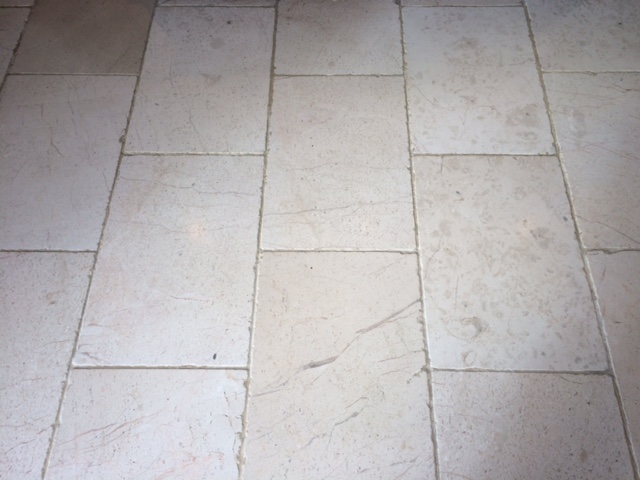Knaresborough is a historic town in North Yorkshire, popular amongst holiday goers for its numerous attractions. I travelled to the area not to visit the attractions, however, but to visit a customer, whose fantastic white Limestone tiled floor was in need of a deep clean.

Limestone is a porous material, meaning that without a sealer dirt can become easily trapped in the pores of the stone, as well as the grout. With this Limestone being naturally white, the dirt was particularly visible, making the tiles look very unsightly. Once deep cleaned the floor would also require a fresh seal to provide long-term protection against muck and stains.

Burnishing a Dirty White Limestone Floor
To treat high end, polished stone floors such as Limestone and Marble, we recommend using the process of burnishing. Simply put, burnishing involves the application of diamond encrusted pads of varying grits, which serve to break down dirt and then polish the stone.
Typically, we use a set of four pads in gradual succession; here, I used the first three pads on the first day. Starting with the Coarse grit pad, along with a little water as lubrication, I polished the Limestone, before repeating the process with Medium and Fine pads to refine the polish.
On the same day, I also cleaned the grout using a solution of one part Tile Doctor Pro-Clean (a high alkaline cleaner) and three parts water. On Limestone floors you should take care to avoid even mildly acidic cleaning products as sensitive stones like Limestone and Travertine can be damaged over time. After successfully cleaning the dirt grout lines, I rinsed the floor before using a wet-vac machine to soak up the residue. The floor was then left to fully dry overnight.
Sealing a White Limestone Floor
The next day, I returned to the property to complete the restoration. Before sealing the tiles, I applied the fourth and final of the burnishing pads to achieve a Very Fine polish.

To seal the tiles, I used Tile Doctor Ultra Seal, the customer didn’t want to darken the stone in the way that a colour enhancing sealer might. Additionally, the customer required a more natural finish, which this product provides.
Then, I polished the excess sealer off with a white buffing pad and left it to dry for an hour, before polishing a final time with the Very Fine grit burnishing pad. With this method, the floor was perfectly dry and the customer could walk on the tiles as soon as I left.

Before leaving my very satisfied customer to enjoy their newly restored Limestone floor, I made sure to impart some aftercare advice. I recommend Tile Doctor Stone Soap for the Limestone (and other polished stone) as its helps to retain the sheen whilst also acting as a general cleaning agent.
Source: Limestone Tile and Stone Cleaning and Sealing Service in North Yorkshire
Tile Doctors operate throughout the UK and are able to provide regular cleaning contracts on a local or national level.